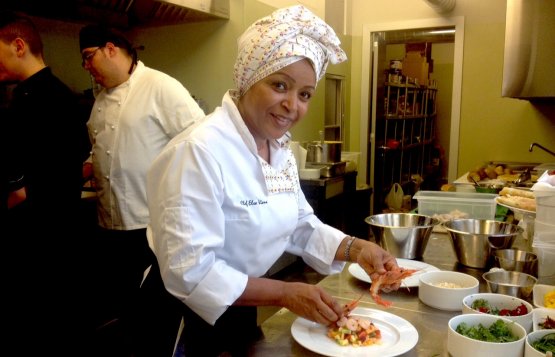Carrot cream with ginger and orange. Prawn soup. Clams with coriander and extra virgin olive oil. Ossobuco with polenta. To which kind of cuisine are we referring? This is a rhetorical question if you got here after reading the title. You wouldn’t have guessed, it would have been difficult to recognise the signs of Angolan cuisine. Because this, in people’s opinion, remains an impossible to place country in Africa, vaguely lashed by internal conflicts to grab petrol and diamonds.
Yet a decade has gone by since those tragic events, years during which the country – four times as big as Italy with less than half its population – experienced a stable political-democratic system and a significant economic growth. You can sense it in front of its pavilion, right at the entrance of Expo, on the left. Outside it is a gigantic structure recalling the typical geometry of Angolan fabric, with large spaces among which natural light seeps in.

Elsa Viana, Angola’s culinary ambassador, with a diploma she received at the Lenôtre School in Paris
Inside, the architecture is created around the
imbondeiro, the baobab, the sacred tree in the local culture (and in Africa in general) here presented in a hi-tech version: there are 4 bundles of pillars projecting together a sequence of images and supporting reticular beams with balconies on which the exhibition takes place. A complex scenic structure that shows images on growth and development, current and future affairs and sustainability, the macro-themes chosen for Expo. With an important section dedicated to women, something certainly not for granted for an African state: one screen, for instance, highlights
Francisca Espirito Santo, the first woman-governor (from the province of Luanda, the capital) in the country’s history.
The cuisine can count on 1,650 km of coastline and a frenetic fishing activity, especially in the south, closer to Namibia (to the north there’s Congo, and to the east Zambia). In the inland there are 58 million hectares of pastures and fields. Three different culinary traditions end up in the pot: Portuguese and Brazilian because of their domination and Italian too (for some historic unknown reason, on top of ossobuco with polenta, dry pasta is also very popular).

In the pavilion, a series of photos enrich the imbondeiro, a hi-tech baobab
The most emblematic dishes in the north are
Manioca funji (a manioca polenta with vegetables) and
Muteta with dry meat, sort of meatballs made with dried pumpkin seeds. To the east, on top of mushrooms (
tortulhos), they also enjoy fermented larva (
catatos). While in the south jack mackerel dominates, usually chargrilled with corn flour, massango or
massambala or
Smoked catfish muamba with peanut ginguba. These dishes, together with what you find at the beginning of this article, enrich the menu of the two restaurants inside the pavilion: the street food one on the ground floor (with chef
Kitaba) and the gourmet one (gourmet, indeed) on the first floor, with chef
Elsa Viana. Average price: 10/15 euros per dish. Pleasure for the palate: high.